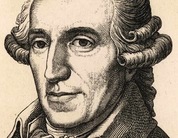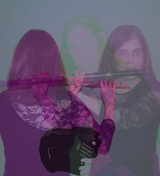
I'm studying classical music research and analysis techniques this year - very exciting stuff. For the first assignment, I focussed on the 3rd, Allegro, movement of Haydn's Trumpet Concerto in E-flat Major, Hob. VIIe: 1. I have always liked Haydn, and it's been really interesting to look at the music from a more rigorous perspective, and to learn about the development of the trumpet.
Franz Joseph Haydn was born in Austria in 1732, the year that Benjamin Franklin began to publish his Almanac a continent away. Haydn spent much of his adult life as musical director to the Hungarian Esterhazy Princes, living through the French Revolution, the American Revolutionary War and the rise of the Industrial Revolution. Like Handel, he spent time in London and was much loved by the British people. He was Mozart’s friend, Hummel’s mentor and a prolific composer. Haydn died in 1809, leaving behind nearly 500 works, including some 108 symphonies and 17 concertos. The Trumpet Concerto in E-flat Major (Concerto per il clarino, E flat) was the last concerto he wrote.
In his sixties, with an established international reputation and an Honorary Doctorate from Oxford, Haydn composed the Trumpet Concerto in E-flat Major specifically for the new “organised” (or keyed) trumpet. Anton Weidinger, perhaps the most virtuoso trumpeter of his day, had invented this trumpet in order to broaden the technical and artistic range of the E flat trumpet. Previously, the Baroque trumpet’s chromatic scope had been limited to the upper two octaves, known as “clarino” (clarion) playing, with much playing done in the more normal court or military “principale” range. By the end of the 18th century, clarino technique had all but died out, with the trumpet relegated to military fanfare use, or solely as a member of the orchestra. It was hoped that Weidinger’s keyed trumpet would enable a fuller chromatic range as well cantabile expression.
The Trumpet Concerto in E flat, composed in 1796 but not performed until 1800, ushered in a new repertoire for the trumpet. It is widely suggested that the reason for the four year delay before the first performance was due to Weidinger’s need for ample time to learn the new instrument and be able to play the solo part. While this concerto is one of Haydn’s most well-known works today, it made little impact at it’s debut and was then lost until 1929. Similarly, Weindinger’s innovation failed to endure although it did lead the way to the valved trumpets still played today.
Movement III, Allegro opens with the orchestra playing a compelling and memorable melody that is recycled throughout the work. This melody is then taken up by the solo trumpeter, with the orchestra acting as accompaniment. For today’s audiences, used to hearing modern trumpets, the simplicity of the main theme masks the extraordinary technical advances made possible by Weidinger’s trumpet. Haydn alternates between military rhythms recalling the trumpet’s previous role, and virtuoso displays including octave leaps, innovative changes of key, and chromatic scale and trill passages comprised of notes that could not previously have been played. At the end, the soloist returns to the trumpet’s lower principal range, almost as if to suggest that all the pyrotechnics were just an illusion, and it’s just an ordinary trumpet, after all.
Franz Joseph Haydn was born in Austria in 1732, the year that Benjamin Franklin began to publish his Almanac a continent away. Haydn spent much of his adult life as musical director to the Hungarian Esterhazy Princes, living through the French Revolution, the American Revolutionary War and the rise of the Industrial Revolution. Like Handel, he spent time in London and was much loved by the British people. He was Mozart’s friend, Hummel’s mentor and a prolific composer. Haydn died in 1809, leaving behind nearly 500 works, including some 108 symphonies and 17 concertos. The Trumpet Concerto in E-flat Major (Concerto per il clarino, E flat) was the last concerto he wrote.
In his sixties, with an established international reputation and an Honorary Doctorate from Oxford, Haydn composed the Trumpet Concerto in E-flat Major specifically for the new “organised” (or keyed) trumpet. Anton Weidinger, perhaps the most virtuoso trumpeter of his day, had invented this trumpet in order to broaden the technical and artistic range of the E flat trumpet. Previously, the Baroque trumpet’s chromatic scope had been limited to the upper two octaves, known as “clarino” (clarion) playing, with much playing done in the more normal court or military “principale” range. By the end of the 18th century, clarino technique had all but died out, with the trumpet relegated to military fanfare use, or solely as a member of the orchestra. It was hoped that Weidinger’s keyed trumpet would enable a fuller chromatic range as well cantabile expression.
The Trumpet Concerto in E flat, composed in 1796 but not performed until 1800, ushered in a new repertoire for the trumpet. It is widely suggested that the reason for the four year delay before the first performance was due to Weidinger’s need for ample time to learn the new instrument and be able to play the solo part. While this concerto is one of Haydn’s most well-known works today, it made little impact at it’s debut and was then lost until 1929. Similarly, Weindinger’s innovation failed to endure although it did lead the way to the valved trumpets still played today.
Movement III, Allegro opens with the orchestra playing a compelling and memorable melody that is recycled throughout the work. This melody is then taken up by the solo trumpeter, with the orchestra acting as accompaniment. For today’s audiences, used to hearing modern trumpets, the simplicity of the main theme masks the extraordinary technical advances made possible by Weidinger’s trumpet. Haydn alternates between military rhythms recalling the trumpet’s previous role, and virtuoso displays including octave leaps, innovative changes of key, and chromatic scale and trill passages comprised of notes that could not previously have been played. At the end, the soloist returns to the trumpet’s lower principal range, almost as if to suggest that all the pyrotechnics were just an illusion, and it’s just an ordinary trumpet, after all.

 RSS Feed
RSS Feed